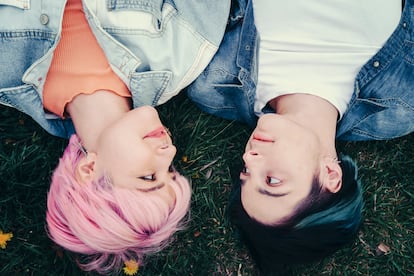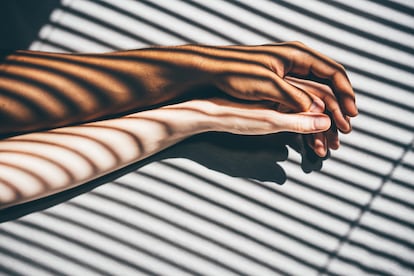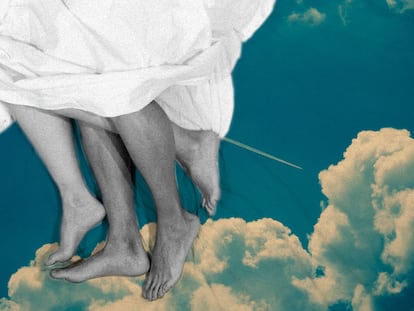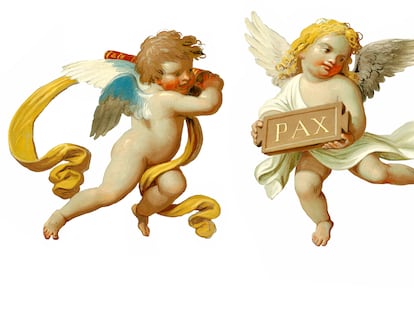It’s not celibacy nor an aversion to sex: Asexuality and the prejudices that surround it
To this day, there are professionals (doctors, biologists and even sexologists) who deny the existence of the sexual orientation, which sets the stage for many asexual people to live through negative experiences, especially when they’re young

“Nowadays they want to give a name to nonsense that doesn’t exist.” That is one of the reactions that Ana J. Cáceres (Mylestring on social media) ran into when she came out of the closet as demisexual, meaning that she is only attracted to other people when they have an affective bond. Demisexuality is located underneath the umbrella of asexuality, an orientation shared by all those who do not feel sexual attraction to anyone, or who require certain conditions for that attraction to develop. It’s far from nonsense: there is an estimated 78 million people or more in the world who are asexual. That number comes from a study entitled Asexuality: prevalence and associated factors in a national probability sample, published in 2004 by Anthony F. Bogaert, which concludes that approximately 1% of the population is asexual. Despite these figures, ignorance and prejudice continues to swirl around the asexual community.
Even if it’s not a term that is entirely foreign to the modern-day lexicon, it can be confused with other concepts. Asexuality as such is not included in Spain’s Royal Spanish Academy, the country’s institution dedicated to linguistic standards, but it does recognize asexual, which is defined as the absence of sex in the reproductive process. Asexual beings include the species of plants and starfish that reproduce via fission, in which a limb is shed, and begins to live independently. “Sticking to this definition alone has resulted in professionals, doctors, biologists and even some sexologists who continue to deny the existence of asexual people,” says Sergio Julve, educator and sex therapist.
It is also confused with celibacy, meaning the absence of sexual relations by choice, and which does not imply a lack of attraction. In asexuality, sexual activity can be present, practiced with a partner or by oneself. “The thing that most surprises people is when you say you’re sexually active, even more so if you tell them you enjoy unconventional sex,” says Cacéres. Although that is true in her case and that of many other asexual people, not everyone is sexually active, which is why it is important to talk about an asexuality umbrella that includes a wide array of possibilities.
The confusion doesn’t end there. Martina González Veiga, psychosexologist, explains that there are people who deny the very existence of asexual people, writing them off as “not having found the right partner or never having had good sex.” Julve notes prejudices like those that hold that asexuals “are single or partner-less for life, are unable to feel sexual pleasure, cannot love others, have an aversion to sex or are overly moralistic, traumatized, or that they’re going through a stage.” Cacéres can speak from experience when it comes to this common ignorance: “Some people say that if you don’t want to have sex on the first date, it’s because you’ve been brainwashed, because society demands that we be prude and, of course, that you really must deconstruct yourself. Coincidentally, the best way to deconstruct yourself is by agreeing to have sex with the person who is lecturing you, what a coincidence.”
Lack of understanding within the community itself
Cacéres, who is 28 years old, says that it took her a long time to recognize that she was on the asexual spectrum. “I took it for granted that everyone felt like me, that it was normal. I didn’t understand the truth until I was 26 years old, until then I myself wasn’t clear on the concepts related to asexuality and its spectrum.” Something that she noticed early on was that she had never fallen in love at first sight. Also, that she had very seldom felt sexual and romantic attraction throughout her life, compared to the other people around her.

This lack of understanding, according to Julve, can have consequences on a person’s experience of their sexuality, especially when they’re young. “If an individual does not feel sexual attraction in a society where there is little sexual education and in which most of young people’s free time is devoted to having the largest amount of sex with the greatest number of people, believing that sexual desire should always be spontaneous and oriented towards coitus, with as few feelings as possible, this person will try to imitate having a sexuality that does not suit him or her, that he or she does not enjoy, and it’s very possible to go through negative experiences at an early age.”
Confusing asexuality with low desire seems like a reasonable misunderstanding. But to address that knowledge gap, it’s important to begin by differentiating desire from attraction. Asexual people do not feel attraction, but they can feel desire, to greater or lesser degrees. “Sexual desire has to do with what mobilizes us to maintain a sexual relationship with someone. It answers the question ‘what for?’ An asexual person can experience desire, and that may not amount to sexual attraction towards the person who activates the feeling, but rather, other things,” says Veiga. Those other things can be a yearning to have a relationship, or experience a certain situation or practice with that person. Julve suggests a clue that can help define one’s desire: “A good indicator, though it may not be a guarantee, is timing. For example, a person who experiences sexual desire and then it goes away, for whatever reason, could have hypoactive sexual desire. On the other hand, a person who has never experienced sexual desire is more likely to be asexual.”
Biased health professionals
On the ninth episode of the eighth season of the series House, the show makes an attempt to explore asexuality. The doctor, who specializes in unusual cases, thinks that it can’t be normal that his patient does not feel any sexual attraction and after further investigation, ultimately finds a tumor in their pituitary gland. The story can serve as an example of the point of view still shared by many health professionals, who reject the very existence of asexuality.
The two sexologists consulted for this article confirm that such lack of understanding can be common. Veiga says that some specialists approach the subject “as something that is not OK, as if people were missing a part, putting them through conversion therapy, pharmacological, sexual or psychological treatment with the goal of leading them to feel attraction.” Julve, who works with LGBTQ advocacy group Stonewall, fights for treatments that purport to cure asexuality, like conversion therapy, to be recognized as equally violent as treatments that look to cure homosexuality.
There’s still a lot we don’t know about the asexuality umbrella, but for the people who live underneath it, theirs is an undeniable reality. Invisibilizing or denying that asexual people even exist will do little to help understand the spectrum. Rather, as Veiga says, such repression will “lead to the restriction of the information and care they need.”
Sign up for our weekly newsletter to get more English-language news coverage from EL PAÍS USA Edition
Tu suscripción se está usando en otro dispositivo
¿Quieres añadir otro usuario a tu suscripción?
Si continúas leyendo en este dispositivo, no se podrá leer en el otro.
FlechaTu suscripción se está usando en otro dispositivo y solo puedes acceder a EL PAÍS desde un dispositivo a la vez.
Si quieres compartir tu cuenta, cambia tu suscripción a la modalidad Premium, así podrás añadir otro usuario. Cada uno accederá con su propia cuenta de email, lo que os permitirá personalizar vuestra experiencia en EL PAÍS.
¿Tienes una suscripción de empresa? Accede aquí para contratar más cuentas.
En el caso de no saber quién está usando tu cuenta, te recomendamos cambiar tu contraseña aquí.
Si decides continuar compartiendo tu cuenta, este mensaje se mostrará en tu dispositivo y en el de la otra persona que está usando tu cuenta de forma indefinida, afectando a tu experiencia de lectura. Puedes consultar aquí los términos y condiciones de la suscripción digital.
More information
Últimas noticias
The new victims of the Republican war on Obamacare: Millions hit by soaring health insurance premiums
A country divided on migrant rights: Some US states expand protections while others restrict them
Venezuela authorizes the release of another 87 political prisoners
There is as much life left to discover on planet Earth as that which is already known
Most viewed
- David King, chemist: ‘There are scientists studying how to cool the planet; nobody should stop these experiments from happening’
- Reinhard Genzel, Nobel laureate in physics: ‘One-minute videos will never give you the truth’
- Oona Chaplin: ‘I told James Cameron that I was living in a treehouse and starting a permaculture project with a friend’
- Sinaloa Cartel war is taking its toll on Los Chapitos
- The Interoceanic Train, the Mexican alternative to the Panama Canal










































